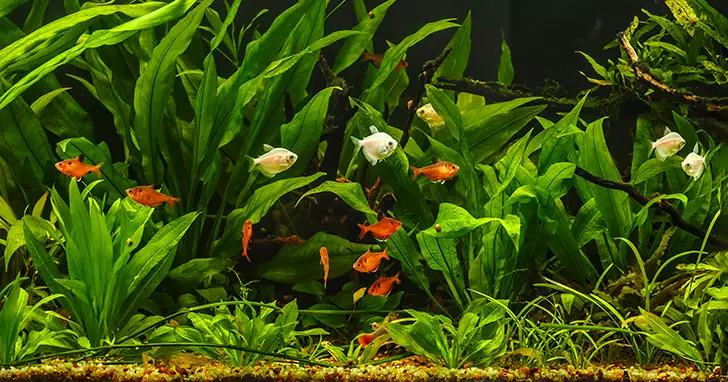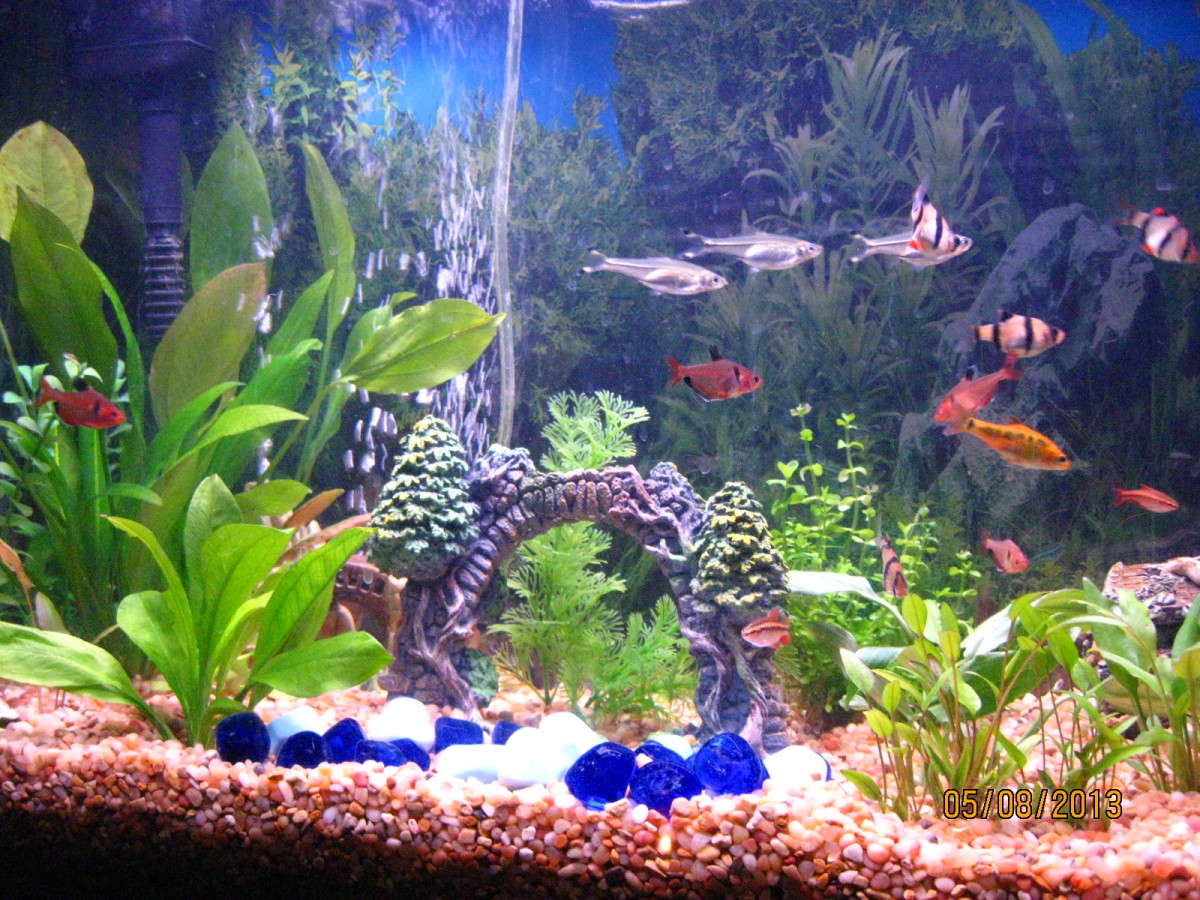Are you looking to add some natural beauty to your home or office space? Consider creating a freshwater aquarium! Not only will it enhance the aesthetic appeal of the room, but it can also be a calming and relaxing hobby.
Creating a freshwater aquarium may seem daunting at first, but with the right guidance and resources, anyone can do it. From selecting the right fish and plants to maintaining the water quality, this project can be both enjoyable and rewarding. So, let’s dive in and explore the world of freshwater aquariums!
To create a natural and beautiful freshwater aquarium, start by selecting a suitable tank and location. Choose a variety of plants and decorations to create a natural habitat for your fish. Use high-quality aquarium substrate and lighting to promote plant growth. Add fish gradually, ensuring they are compatible with each other and the environment. Regularly test and maintain water quality to keep your aquarium healthy and thriving.

Creating a Natural and Beautiful Freshwater Aquarium
Freshwater aquariums are a beautiful addition to any home or office. They provide a glimpse into a tranquil underwater world and can be a source of relaxation and stress relief. Creating a natural and beautiful freshwater aquarium requires some planning and attention to detail. In this article, we will explore the steps involved in setting up a stunning freshwater aquarium.
Choosing the Right Tank
The first step in creating a beautiful freshwater aquarium is choosing the right tank. You need to consider the size of the tank, the location where it will be placed, and the type of fish you want to keep. A larger tank is always better, as it provides more space for your fish to swim and reduces the risk of overcrowding. It is also important to choose a location that is away from direct sunlight and heat sources.
Once you have decided on the size and location of your tank, you need to choose the type of aquarium. There are two types of freshwater aquariums: planted and non-planted. Planted aquariums require more maintenance and attention, but they offer a more natural and beautiful look. Non-planted aquariums are easier to maintain, but they lack the natural beauty of a planted aquarium.
Setting Up the Tank
After choosing the right tank, the next step is to set it up. This involves adding substrate, decorations, and plants. The substrate is the material that lines the bottom of the tank and provides a base for the plants. You can choose from a variety of substrates, including gravel, sand, and soil.
Decorations, such as rocks and driftwood, can be added to create a natural look. Plants are also an important part of a freshwater aquarium. They provide oxygen and help to purify the water. You can choose from a variety of aquatic plants, such as Java Moss, Anubias, and Java Fern.
Choosing the Right Fish
Choosing the right fish is another important step in creating a natural and beautiful freshwater aquarium. You need to consider the size of the fish, their compatibility with other fish, and their water requirements. Some popular freshwater fish include Neon Tetras, Guppies, and Angelfish.
It is important to research the fish you want to keep to ensure they are compatible with each other and the water conditions in your tank. You should also consider the size of the fish when they are fully grown, as overcrowding can lead to health problems and stress.
Filtering and Heating the Water
Filtering and heating the water is essential for maintaining a healthy and beautiful freshwater aquarium. A filter helps to remove waste and debris from the water, while a heater maintains a consistent temperature.
There are several types of filters available, including hang-on-back filters, canister filters, and sponge filters. The type of filter you choose will depend on the size of your tank and the type of fish you have. Similarly, the type of heater you choose will depend on the size of your tank and the temperature requirements of your fish.
Lighting the Tank
Lighting is an important part of creating a natural and beautiful freshwater aquarium. It not only enhances the beauty of your tank but also helps to promote the growth of plants. You should choose a lighting system that is appropriate for the size of your tank and the type of plants you have.
There are several types of lighting systems available, including LED, fluorescent, and incandescent. LED lighting is energy-efficient and provides a natural-looking light. Fluorescent lighting is also energy-efficient and is ideal for growing plants. Incandescent lighting is less energy-efficient but provides a warm and natural-looking light.
Maintaining the Aquarium
Maintaining your freshwater aquarium is essential for keeping it healthy and beautiful. This includes regular water changes, cleaning the tank, and monitoring the water parameters.
You should aim to change 10-20% of the water in your tank every week to remove waste and debris. You should also clean the tank regularly, including the substrate, decorations, and plants. Monitoring the water parameters, such as pH and temperature, is also important to ensure a healthy environment for your fish.
The Benefits of a Freshwater Aquarium
A freshwater aquarium is not only a beautiful addition to your home or office but also offers several benefits. It can reduce stress and anxiety, lower blood pressure, and improve your mood. It also provides a source of entertainment and education for children and adults alike.
Freshwater Aquariums vs. Saltwater Aquariums
When it comes to aquariums, there are two main types: freshwater and saltwater. While both offer their own unique beauty and challenges, freshwater aquariums are generally easier to maintain and less expensive.
Freshwater fish are also generally hardier and easier to care for than saltwater fish. Saltwater aquariums require more advanced equipment and a more precise balance of water parameters.
Conclusion
Creating a natural and beautiful freshwater aquarium requires some planning and attention to detail, but the end result is a stunning addition to any home or office. By choosing the right tank, setting it up properly, choosing the right fish, filtering and heating the water, lighting the tank, and maintaining the aquarium, you can create a healthy and beautiful environment for your fish.
Frequently Asked Questions
What are the basic requirements for creating a natural and beautiful freshwater aquarium?
The basic requirements for creating a natural and beautiful freshwater aquarium are a suitable tank, a filtration system, substrate, lighting, plants, and decorations. The size of the tank should be appropriate for the number of fish and plants you want to keep. A filtration system is necessary to maintain a clean and healthy environment for your aquatic pets. The substrate is the material that covers the bottom of the tank and provides a natural environment for the plants and fish. Lighting is essential for the growth of plants and to enhance the beauty of the aquarium. Lastly, plants and decorations help to create a natural and visually appealing environment for your fish.
It is important to research the specific requirements for the plants and fish you plan to keep in your aquarium. Different types of plants and fish have different needs for temperature, water chemistry, and lighting. By providing the appropriate environment, you can create a natural and beautiful freshwater aquarium that is both healthy and visually appealing.
How do I cycle my aquarium before adding fish?
Cycling your aquarium is the process of establishing the beneficial bacteria needed to break down waste products produced by fish and other aquatic animals. This process can take several weeks to complete. To cycle your aquarium, you will need to add a source of ammonia, such as fish food or pure ammonia, to the tank. The bacteria will then begin to grow and establish themselves in the filter media and substrate.
It is important to monitor the ammonia, nitrite, and nitrate levels during the cycling process. Once the levels of ammonia and nitrite have peaked and started to decline, and the nitrate levels have started to rise, the aquarium is ready for fish. It is important to start with a small number of fish and gradually add more over time to avoid overwhelming the newly established bacteria population.
What types of plants are suitable for a freshwater aquarium?
There are many types of plants that are suitable for a freshwater aquarium, including java fern, anubias, amazon sword, and java moss. These plants are relatively easy to care for and do not require high levels of lighting or CO2 injection. They also provide important benefits to the aquarium ecosystem, such as oxygen production, nutrient absorption, and hiding places for fish.
When selecting plants for your aquarium, it is important to consider the specific requirements of the plants and the fish you plan to keep. Some plants require higher levels of lighting or specific water parameters, such as pH or hardness. It is also important to consider the growth rate of the plants, as some can quickly overtake the aquarium if not properly trimmed.
How often should I perform water changes in my aquarium?
Regular water changes are an important part of maintaining a healthy and beautiful freshwater aquarium. The frequency of water changes will depend on the size of the aquarium, the number of fish, and the type of filtration system in use. As a general rule, a 10-20% water change should be performed every 1-2 weeks.
During a water change, it is important to remove any uneaten food, debris, or waste products from the substrate. This will help to maintain water quality and prevent the buildup of harmful chemicals and bacteria. It is also a good time to trim any excess plant growth or perform any necessary maintenance on the filtration system.
How can I prevent algae growth in my aquarium?
Algae growth is a common problem in freshwater aquariums. To prevent algae growth, it is important to maintain proper water chemistry and lighting levels. Excess nutrients, such as nitrates and phosphates, can contribute to algae growth, so it is important to avoid overfeeding and perform regular water changes.
Lighting levels should also be carefully controlled to prevent excess algae growth. The duration and intensity of lighting should be appropriate for the plants and fish in the aquarium. It is also important to avoid placing the aquarium in direct sunlight, as this can contribute to excess algae growth.
Lastly, maintaining a healthy and diverse population of aquatic plants can help to prevent algae growth by competing for nutrients and providing oxygen to the water. By following these tips, you can prevent algae growth and maintain a natural and beautiful freshwater aquarium.

How to make THE EASIEST Planted Fish Tank | You Suck At Fish Tanks
In conclusion, creating a natural and beautiful freshwater aquarium is a rewarding experience that requires patience, attention to detail, and a love for aquatic life. By following the steps outlined in this guide, you can transform a simple tank into a thriving ecosystem that will captivate and delight all who see it.
Remember to choose your fish and plants carefully, and to provide them with the right environment to thrive. Pay attention to the water quality and temperature, and make adjustments as needed to ensure that your aquarium remains healthy and vibrant.
With a little time and effort, you can create a stunning aquatic paradise that will bring joy and beauty to your home for years to come. So why not get started today, and discover the wonders of a natural and beautiful freshwater aquarium?
